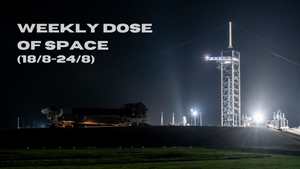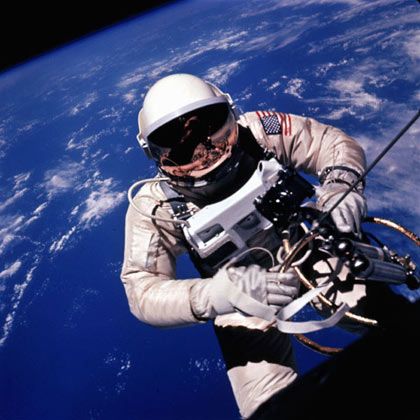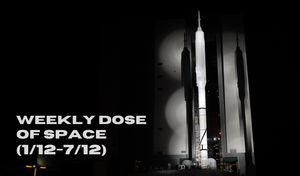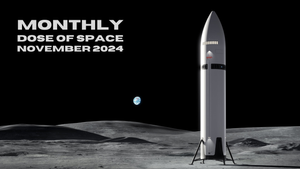
Weekly Dose of Space (18/8-24/8)
Welcome back to Weekly Dose of Space! This week had two orbital launches occur worldwide, one each from both major space powers. News this week had NASA finally deciding how to end the Starliner Crew Flight Test mission, and Rocket Factory Augsburg losing its first flight booster. As always, we'll also look ahead to what the worldwide launch schedule might look like next week.
SpaceX
This week at Starbase began on August 19th when the ninth, and final, module of the second launch tower rolled out to the launch site. Two days later, on August 21st, the ninth module was lifted onto the launch tower. After the lift, teams quickly got to work securing the module and connecting various systems ahead of further hardware installation.

Activity at Starbase was relatively quieter after the stacking, so let's go over what needs to be done ahead of Starbase having two operational launchpads.
The most obvious is an orbital launch mount, although a different design is expected to be built, possibly with a flame trench. SpaceX already has the second towers 'chopsticks' assembled and ready for installation. Before installing the 'chopsticks', teams need to install the tower's pulley system that will allow the 'chopsticks' to move vertically, for operations like vehicle stacking and booster catches.
Launches This Week
August 20th - Falcon 9 with Starlink Group 10-5
SpaceX launched a Falcon 9 from Space Launch Complex 40, in Florida, carrying twenty-two Starlink satellites to low Earth orbit. The booster for this mission was B1085, making its first flight and landing downrange on the drone ship 'A Shortfall of Gravitas'.

August 22nd - Long March 7A with ChinaSat-4A
The second Long March 7A launch of 2024 carried ChinaSat-4A to a geostationary transfer orbit from LC-201 at the Wenchang Space Launch Site. ChinaSat-4A will reportedly be used to provide data, radio, voice, and television transmission services.

In Other Space News
Starliner crew to return in 2025

NASA has decided, on August 24th, that the two astronauts onboard Starliner for its Crew Flight Test will return on the Crew-9 SpaceX Crew Dragon in February of 2025. Astronauts Sunita Williams and Butch Wilmore launch to the International Space Station aboard Starliner back on June 5th.
The two astronauts were originally slated to spend just over eight days aboard the International Space Station and have now been up there for over two months. Returning with Crew-9 would increase their total time aboard the station to eight months.
Starliner will return to Earth uncrewed after a planned undocking in early September. After Starliner departs, and while Crew-8 is still at the station, the Crew-8 Crew Dragon spacecraft will be the lifeboat for Sunita and Butch. Crew-9 will launch to the space station in late September with only two astronauts onboard, while bringing spacesuits for Sunita and Butch.
Speaking at a press conference about the decision, Steve Stich, Manager of NASA’s Commercial Crew Program, said the following about the spacecraft:
“Starliner is a very capable spacecraft and, ultimately, this comes down to needing a higher level of certainty to perform a crewed return,” – “The NASA and Boeing teams have completed a tremendous amount of testing and analysis, and this flight test is providing critical information on Starliner’s performance in space. Our efforts will help prepare for the uncrewed return and will greatly benefit future corrective actions for the spacecraft.”
NASA Administrator Bill Nelson also spoke at the press conference saying:
“Spaceflight is risky, even at its safest and most routine. A test flight, by nature, is neither safe, nor routine. The decision to keep Butch and Suni aboard the International Space Station and bring Boeing’s Starliner home uncrewed is the result of our commitment to safety: our core value and our North Star,” – “I’m grateful to both the NASA and Boeing teams for all their incredible and detailed work.”
Both Sunita Williams and Butch Wilmore are in orbit for the third time.
NASA awards contracts to three OTV companies
On August 22nd, NASA announced that it had selected three new companies for its Venture-Class Acquisition of Dedicated and Rideshare (VADR) contract bidding process. These three newly selected companies are; Impulse Space, Arrow Science and Technology, and Momentus Space.
The selection of these companies is somewhat unconventional for a VADR bidding process, as it is typically for launching small satellites that will accept higher-risk launch services. None of the three own or operate an orbital launch vehicle, and instead book slots on vehicles like SpaceX's Falcon 9.
Impulse Space is currently operates its Mira orbital transfer vehicle, and is developing a high-energy kick stage under the name Helios. Momentus Space also operates orbital transfer vehicles. Arrow Science and Technology manufactures satellite deployment solutions.
RFA ONE first flight delayed to 2025
UPDATE on our S1 test anomaly!
— Rocket Factory Augsburg (@rfa_space) August 23, 2024
Our first stage is gone – but we have collected a significant amount of data and film footage. After reviewing it, we want to share some insights into the technical analysis, preliminary conclusions and our next steps ⬇️ pic.twitter.com/FnGHjTCS2g
Rocket Factory Augsburg's update about its test anomaly on X.
Back on Monday, August 19th, Rocket Factory Augsburg experienced an anomaly when testing its first-stage of its upcoming RFA ONE launch vehicle. This anomaly led to the loss of the first-stage.
The company released an update about the anomaly on August 23rd, saying that the most likely cause of the anomaly was a fire in the oxygen pump in one of the Helix engines. It was also stated that another first-stage is in production, with over one hundred design changes and fixes.
SpaceNews reached out to Rocket Factory Augsburg and found out that another firing at the SaxaVord Spaceport won't occur this year, and that the maiden flight of RFA ONE is now expected next year.
What to Expect Next Week
Starbase
The fifth test flight of SpaceX's Starship-Super Heavy vehicle is still awaiting regulatory approval from the U.S. Federal Aviation Administration. This latest flight test requires a change in the flight plan, notably a potential landing of Booster 12 back at the launch site on the launch towers 'chopsticks'.
Both vehicles for flight five, Booster 12 and Ship 30, are ready for flight pending a possible wet dress rehearsal.
August 25th - Falcon 9 with Starlink Group 9-5
SpaceX is expecting to fly a Falcon 9 from Space Launch Complex 4E carrying a batch of Starlink satellites to low Earth orbit.
August 27th - Falcon 9 with Polaris Dawn
The Polaris Dawn mission is expected to launch from Launch Complex 39A, in Florida, on a Falcon 9 carrying it to low Earth orbit with four crew onboard. In addition to conducting medical research, the mission would test extravehicular spacesuits made by SpaceX and laser-based Starlink communications on Crew Dragon.
The crew for Polaris Dawn is Commander Jared Isaacman, Pilot Scott Poteet, Mission Specialist Anna Menon, and Mission Specialist Sarah Gillis.
August 28th - Falcon 9 with Starlink Group 8-6
A Falcon 9 is expected to launch from Space Launch Complex 40 carrying another batch of Starlink satellites to low Earth orbit.
August 29th - Ceres-1S with a to-be-announced payload
Galactic Energy is believed to be targeting August 29th for another launch of Ceres-1S from a sea launch platform. The launch platform for this launch will be positioned in the Yellow Sea, off the East coast of China.
August 29th - New Shepard for NS-26
New Shepard is expected to fly another six passengers on a sub-orbital mission above the Kármán line. The passengers are Ephraim Rabin, Nicolina Elrick, Eugene Grin, Rob Ferl, Karsen Kitchen, and Eiman Jahangir. This mission will fly from Blue Origin's launch site in West Texas.
August 30th - Falcon 9 with NROL-113
SpaceX is expected to launch another batch of classified reconnaissance satellites, on behalf of the U.S. National Reconnaissance Office, from Space Launch Complex 4E.




